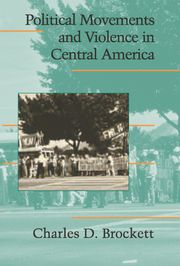Book contents
- Frontmatter
- Contents
- Figures, Tables, and Maps
- Abbreviations and Acronyms
- Acknowledgments
- 1 INTRODUCTION
- Part One From Grievances to Contentious Movements
- 2 THE SOCIAL CONSTRUCTION OF GRIEVANCES
- 3 THE EMERGENCE OF URBAN CONTENTIOUS MOVEMENTS: EL SALVADOR
- 4 THE EMERGENCE OF URBAN CONTENTIOUS MOVEMENTS: GUATEMALA
- 5 CONTENTIOUS PEASANTS AND THE PROBLEM OF CONSCIOUSNESS RAISING
- Part Two Opportunity, Contention, and Repression
- References
- Index
3 - THE EMERGENCE OF URBAN CONTENTIOUS MOVEMENTS: EL SALVADOR
Published online by Cambridge University Press: 23 November 2009
- Frontmatter
- Contents
- Figures, Tables, and Maps
- Abbreviations and Acronyms
- Acknowledgments
- 1 INTRODUCTION
- Part One From Grievances to Contentious Movements
- 2 THE SOCIAL CONSTRUCTION OF GRIEVANCES
- 3 THE EMERGENCE OF URBAN CONTENTIOUS MOVEMENTS: EL SALVADOR
- 4 THE EMERGENCE OF URBAN CONTENTIOUS MOVEMENTS: GUATEMALA
- 5 CONTENTIOUS PEASANTS AND THE PROBLEM OF CONSCIOUSNESS RAISING
- Part Two Opportunity, Contention, and Repression
- References
- Index
Summary
Most of the time in most of the world the poor and the powerless are not politically active and certainly not contentious when they are. Contentious movements occur infrequently, invariably enlist far less than the majority of the aggrieved population when they do, and seldom persist for long. This is especially true for the most radical expression of contention, revolutionary movements.
For radical activists (and often for scholars as well), the political quiescence of the disadvantaged is seen as self-defeating if not irrational, resulting from counterproductive values and attitudes. However, with the assistance provided by activists – be that education, training, resources, or consciousness-raising – the poor and powerless can come to see their condition not as natural but as socially created, not by abstract forces but by identifiable elites who are perpetuating their own enrichment at the expense of the vast majority. With this change in understanding, the theory goes, contentious activism emerges and grows, at first motivated usually by individuals' own immediate material interests and those of their closest social affiliations. But with time and further transformation of consciousness, they might even come to understand the need for revolutionary changes in the very social order itself.
From a different standpoint, the reluctance of the disadvantaged (and other nonelites) to join the contentious causes of political activists is seldom irrational or the result of counterproductive attitudes.
- Type
- Chapter
- Information
- Political Movements and Violence in Central America , pp. 69 - 96Publisher: Cambridge University PressPrint publication year: 2005

